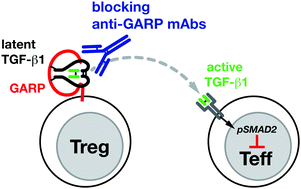当前位置:
X-MOL 学术
›
Mol. Biosyst.
›
论文详情
Our official English website, www.x-mol.net, welcomes your feedback! (Note: you will need to create a separate account there.)
Role of GARP in the activation of latent TGF-β1
Molecular BioSystems Pub Date : 2017-08-10 00:00:00 , DOI: 10.1039/c7mb00251c Julie Stockis 1, 2, 3, 4 , Olivier Dedobbeleer 1, 2, 3, 4 , Sophie Lucas 1, 2, 3, 4
Molecular BioSystems Pub Date : 2017-08-10 00:00:00 , DOI: 10.1039/c7mb00251c Julie Stockis 1, 2, 3, 4 , Olivier Dedobbeleer 1, 2, 3, 4 , Sophie Lucas 1, 2, 3, 4
Affiliation

|
TGF-β1, 2 and 3 cytokines are involved in many cellular processes including cell proliferation, differentiation, migration and survival. Whereas TGF-β2 and 3 play important roles in embryonic development, TGF-β1 is mostly implicated in controlling immune responses after birth. The production of TGF-β1 is a tightly regulated process, occurring mostly at a post-translational level. Virtually all cells produce the latent, inactive form of TGF-β1. In latent TGF-β1, the mature TGF-β1 dimer is non-covalently associated to the Latency Associated Peptide, or LAP, which prevents binding to the TGF-β1 receptor. Activation of the cytokine implies release of mature TGF-β1 from LAP. Only a few cell types activate latent TGF-β1, via mechanisms that are cell type specific. Proteins such as integrins, proteases and thrombospondin-1 activate TGF-β1 in epithelial cells, fibroblasts and dendritic cells. More recently, the protein GARP was shown to be involved in TGF-β1 activation by regulatory T cells (Treg), a subset of CD4+ T lymphocytes specialized in suppression of immune responses. GARP is a transmembrane protein that binds latent-TGF-β1 and tethers it on the Treg surface. The role of GARP was studied mostly in Tregs, and this was recently reviewed in L. Sun, H. Jin and H. Li, Oncotarget, 2016, 7, 42826–42836. However, GARP is also expressed in non-immune cells. This review focuses on the roles of GARP in latent TGF-β1 activation by immune and non-immune cells.
中文翻译:

GARP在潜在TGF-β1激活中的作用
TGF-β1、2和3细胞因子参与许多细胞过程,包括细胞增殖,分化,迁移和存活。TGF-β2和3在胚胎发育中起着重要作用,而TGF-β1主要与控制出生后的免疫反应有关。TGF-β1的产生是一个严格调控的过程,主要发生在翻译后水平。实际上,所有细胞都产生潜在的,非活性形式的TGF-β1。在潜在的TGF-β1中,成熟的TGF-β1二聚体与潜伏相关肽或LAP非共价结合,从而阻止了与TGF-β1受体的结合。细胞因子的激活意味着成熟的TGF-β1从LAP中释放出来。只有少数几种细胞会通过以下途径激活潜在的TGF-β1特定于细胞类型的机制。诸如整联蛋白,蛋白酶和血小板反应蛋白-1之类的蛋白激活上皮细胞,成纤维细胞和树突状细胞中的TGF-β1。最近,蛋白质GARP被证明与调节性T细胞(Treg)参与TGF-β1活化有关,调节性T细胞是专门抑制免疫应答的CD4 + T淋巴细胞的一个子集。GARP是一种跨膜蛋白,可结合潜在的TGF-β1并将其束缚在Treg表面。GARP的作用在调节性T细胞主要是研究,这是最近在L.太阳,金H.和H.李,审查Oncotarget,2016年,7,42826-42836。然而,GARP也在非免疫细胞中表达。这篇综述着重于GARP在免疫和非免疫细胞潜在的TGF-β1激活中的作用。
更新日期:2017-08-10
中文翻译:

GARP在潜在TGF-β1激活中的作用
TGF-β1、2和3细胞因子参与许多细胞过程,包括细胞增殖,分化,迁移和存活。TGF-β2和3在胚胎发育中起着重要作用,而TGF-β1主要与控制出生后的免疫反应有关。TGF-β1的产生是一个严格调控的过程,主要发生在翻译后水平。实际上,所有细胞都产生潜在的,非活性形式的TGF-β1。在潜在的TGF-β1中,成熟的TGF-β1二聚体与潜伏相关肽或LAP非共价结合,从而阻止了与TGF-β1受体的结合。细胞因子的激活意味着成熟的TGF-β1从LAP中释放出来。只有少数几种细胞会通过以下途径激活潜在的TGF-β1特定于细胞类型的机制。诸如整联蛋白,蛋白酶和血小板反应蛋白-1之类的蛋白激活上皮细胞,成纤维细胞和树突状细胞中的TGF-β1。最近,蛋白质GARP被证明与调节性T细胞(Treg)参与TGF-β1活化有关,调节性T细胞是专门抑制免疫应答的CD4 + T淋巴细胞的一个子集。GARP是一种跨膜蛋白,可结合潜在的TGF-β1并将其束缚在Treg表面。GARP的作用在调节性T细胞主要是研究,这是最近在L.太阳,金H.和H.李,审查Oncotarget,2016年,7,42826-42836。然而,GARP也在非免疫细胞中表达。这篇综述着重于GARP在免疫和非免疫细胞潜在的TGF-β1激活中的作用。



























 京公网安备 11010802027423号
京公网安备 11010802027423号